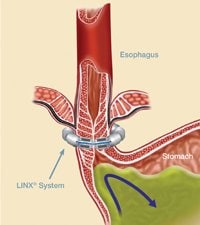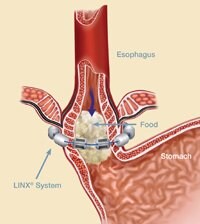Relief for Acid Reflux Sufferers
If you suffer from heartburn or acid reflux, you may have gastroesophageal reflux disease (GERD).
Acid reflux or gastroesophageal reflux disease (GERD) is a chronic, often progressive condition that affects one in five adults in the U.S. While many men and women manage their symptoms with medications and lifestyle changes, approximately 40 percent of suffers are still not finding the relief they need. The good news is that there is a new minimally-invasive procedure, utilizing the LINX® Reflux Management System, which is designed to alleviate symptoms and strengthen the lower esophageal sphincter.
What is Reflux
Reflux is a disease caused by a weak muscle in your esophagus called the Lower Esophageal Sphincter (LES). The LES is your body's reflux barrier. Normally the LES acts as a one way valve, allowing food and liquid to pass into the stomach and preventing stomach contents to flow back up the esophagus. A person with reflux, the weakened LES allows harmful acid and bile to flow back into the esophagus.
What is Hiatal Hernia
Hiatal hernia is a condition is which part of the stomach migrates into the chest. This is a common cause of reflux but can also cause a variety of other symptoms such as regurgitation, painful swallowing, and a sensation that food getting stuck in the chest. Large hiatal hernias can also cause difficult breathing as the large stomach can presents the chest from expanding properly. In extreme situations, it can also cause complete obstruction of the stomach which is an emergency.
Signs and Symptoms of GERD
- A burning sensation in your chest (heartburn), usually after eating, which might be worse at night
- Bad breath and dental erosion
- Chest pain
- Consistent Cough
- Difficulty sleeping at night
- Difficulty swallowing
- Feeling of a lump in your throat
- Hoarseness
- Regurgitation of food or sour liquid (acid reflux)
Treatment Options
- Medications - medicine for GERD are designed to suppress the production of stomach acid, but they do not address the cause of GERD
- Laparoscopic/Robotic Fundoplication (with or without hiatal hernia repair) - This is a minimally procedure in which the surgeon restores the normal anatomy, correcting the hernia and wraps the top of the stomach around the lower esophagus to prevent further reflux.
- LINX Reflux Management System - the only available FDA-approved device for the treatment of GERD. The LINX device is a small, flexible band of magnets enclosed in titanium beads connected by titanium wires. The magnetic attraction between the beads helps keep a weak esophageal sphincter closed to stop reflux at its source.
Advantages of LINX
- Minimally invasive - a surgeon will make a small laparoscopic incision (as small as a pencil eraser) in the abdomen and positions the LINX device around the esophagus, just above the stomach.
- No changes to your anatomy - The LINX device is implanted around your esophagus and doesn't require surgically altering your digestive system.
- No lengthy hospital stay - It takes about 30 minutes (under general anesthesia) to implant the device, and patients generally go home on the same day or the next.
- No change to esophageal function - LINX doesn't interfere with your ability to swallow food or liquids and doesn't result in bloating by limiting the passage of air from your stomach.
- Removable - If in the future you and your doctor decide on a different treatment plan, the LINX device does not limit your choices. It can be removed with an additional laparoscopic procedure.
- Non-interfering - The LINX device will not affect airport security and you can safely undergo a wide range of diagnostic imaging tests including: x-ray, ultrasound, PET scan, CT scan and MRI (1.5T).
The LINX Device and How It Works
 |
The LINX device is a quarter-sized flexible band of magnetic titanium beads that's placed around the failing LES to prevent stomach acid for entering the esophagus.
|
 |
The LINX devise is placed around the Lower Esophageal Sphincter (LES) to restore sphincter competence to stop reflux. |
 |
The LINX magnets open to allow food and liquid to pass, and then close to prevent stomach contents from moving up - stopping reflux at its source.
|
®The LINX Management System is a registered trademark of Johnson & Johnson
